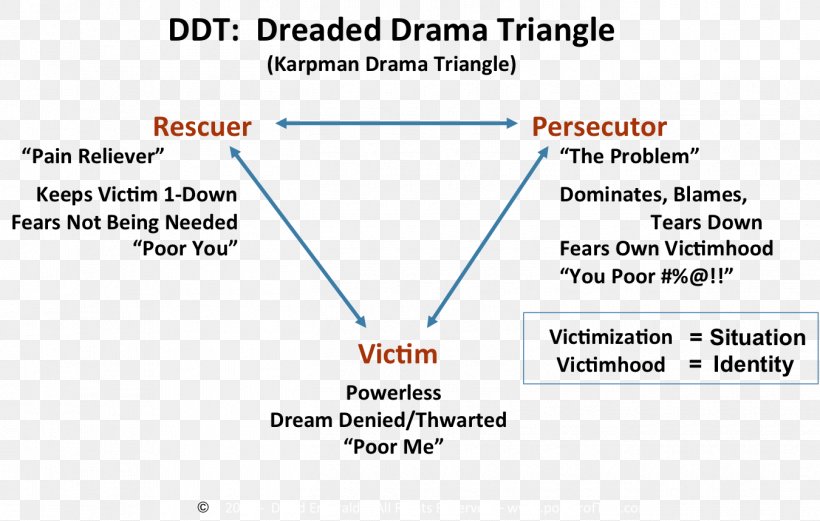
Hawkins / Opferhaltung
Inhaltsverzeichnis: (verbergen)
 Karpmansches Dramadreieck: |
|
|
|
Das Täter ↔ Opfer-Denkmodell ist so tief in die existierende Weltanschauung des Massenbewusstseins eingegraben, dass es als Perspektive nur selten in Frage gestellt wird. Eine einfache Netz-Recherche ergibt, dass sich in Suchmaschi-
Das TO-Modell beruht auf dualistischem Spaltdenken und trifft nicht zu. Die Täter↔Opfer-Betrachtungsweise wirkt sich wie ein gesellschaftlicher Virus aus, da sie bewusstseinsmäßig lediglich auf BW 135 schwingt. Sie befindet sich zwischen den Notstandsgefühlen Angst und Wut).
Eine Opferhaltung einzunehmen, ist nicht integer. Sie ent-
Die an Tätern und (gewalttätigen) Tatkräftigen orientierte Kul-
Das 1968 von Stephen Karpman entwickelte Dramadrei-
Wenn drei nicht in Seinem Namen zusammenkommen..., wirkt das Dramadreieck. |
Pschologische Mechanismen
Opferphrasen / Opfervokabular
| Written reference / Media offering: ► Article 10 Signs Someone's Always Playing the Victim, presented by the blogspot psych2go.net, Sidney, 31. August 2020 ► Educative video 10 Signs Someone’s Always Playing the Victim, YouTube film, 6:05 minutes duration, posted 13. November 2020 |
Ein ultimatives OPFER, das als RETTER (Erlöser) kam und posthum als König (in der TÄTERrolle?) eines inwendig vorhande-
nen Reich Gottes verehrt wird, ist der gewaltlose Avatar und Heiland Jesus von Nazareth [BW 1000], der bereit war, in den Tod
zu gehen, der Gottes Wille war und ihm von der Volksmenge zugeteilt und von den Machthabern vor Ort vollstreckt wurde.
Ähnlich erging es auch dem griechischen Philosophen Sokrates [BW 540]. Ohne die ihm gebotene Fluchtmöglichkeit zu ergreifen, trank er willig den Schierlingsbecher aus, den ihm ein Athener Bürgergremium zugedacht hatte, um den 70-jährigen Fragesteller, der als "Volksschädling" gesehen wurde, zu beseitigen.
In beiden Fällen hat das "Opfer" mit dem Täter-Opfer-Denkmodell, so wie oben beschrieben, nichts gemein. Jesus und Sokrates gaben ihr irdisches Leben in Erfüllung ihres Seelenkontrakts in Ausrichtung auf das Göttliche. Sie handelten als Menschheits-
lehrer, ohne sich als Geopferte zu bemitleiden. Da sie um die Begrenztheit des menschlichen Verstand/Gemüts ihrer "Täter" (Verfolger) wussten, baten sie um Vergebung für sie.
| Siehe auch: ► Mitverantwortung |
Brot und Zirkusspiele dienen dazu, eine blutrünstige Menge zu unterhalten.
Während der Regierungszeit des wahnsinnigen (narzisstisch selbst überhöhten) Kaisers Nero in Rom wurden die Christen der Frühzeit als angebliche Sündenböcke seiner Brandstiftung verfolgt. Die Min-
derheit der Nachfolger Christi fürchtete sich davor, von den freigelas-
senen hungrigen Löwen im Kolloseum gefressen zu werden. Die
Gruppe von Christen, die von Nero, dem schaulustigen Publikum und den Löwen verfolgt wurden, überwand ihre Todesangst, indem sie Gott lobpreisten und geistliche Lieder sangen.
Fassungslos rief Kaiser Nero mehrmals während des Mordspektakels aus:
Nachdem die Löwen gesättigt waren, inspizierte der Auftraggeber der "Volksbelustigung" die blutigen Leichenreste in der Arena. Was er dort fand, waren Gläubige, die mit einem Lächeln auf
ihrem Gesicht gestorben waren.
Das überstieg in der Tat das Fassungsvermögen des Kaisers, der dem Opfer-Täter-Denkmodell anhing.
| Quelle: ► Videoausschnitt aus dem MGM Monumentalfilm Wohin gehst du?, Regisseur Mervyn LeRoy, Hauptfiguren gespielt von Robert Taylor, Deborah Kerr und Peter Ustinov, 1951 |
| Siehe auch: ► Musik |

Native American spirituality calibrates very high at LoC 500.
Persönliche Bekenntnisse
Appell

Aufruf
Schlussfolgerung
|
Sündenbockmotiv: Abergläubische Ortsansässige waren überzeugt, dass der See alljährlich ein Opfer reklamiert.
Literaturzitate
"A sacrifice by fire, burnt offering," from Greek holokauston "a thing wholly burnt," neuter of holokaustos "burned whole," from holos "whole" linked to HOLY (see holo-) + kaustos, verbal adjective of kaiein "to burn." Baal Ba-El (son of god)
Personal avowals
Recommendations

|
Scapegoating modus: Superstitious belief of the locals supposed that annually the lake would return to claim a victim.
Literary quotes
| ||||||||||||||||||
| References: ► Gary Lachman (*1955) US American cultural pundit, musician, writer on mysticism and the occult, Politics and the Occult. The Left, the Right, and the Radically Unseen, Quest Books, 1st edition 1. November 2008 History of the Knights Templar and the medieval Gnostic Cathars, occult Freemasonic roots of America, French Revolution, Gurdjieff, swastika, Soviet interest in UFOs, CIA, LSD, Age of Aquarius, millenarian politics, Islamic terrorism, fundamentalism ► Joseph Dillard, Ph.D., US American psychotherapist, developer of dreamwork method Integral Deep Listening (IDL), author, Escaping the Drama Triangle in the Three Realms. Relationships, Thinking and Dreaming, Kindle, 12. March 2017 |
| ||||||||||||||||||||||||||||||||||||
| ||||||||||||||||||||||||||||
| Source: ► Article by Shahida Arabi, US American psychologist, bestselling author, 7 Spiritual Ideas That Enable Abuse And Shame The Victim, presented by the website Thought Catalog, 19. January 2017 |
| See also: ► Biblical forgiveness myths – Maria Mayo ► Shame and ► Mind control |
|
|

| Note: Antidotes to fear [of feared authority figures] are: laughter, singing, acting, whispering, talking to pets or babies. Disabling fears of suppressive authority tend to disappear when one engages in activities that naturally unfold in an atmosphere of trust. Stuttering often vanishes when stutterers are singing or laughing. It is not possible to eat me without insisting that I sing praises of my devourer? Fyodor Mikhailovich Dostoevsky (1821-1881) Russian writer of novels, short stories and essays, cited in: Goodreads Quotable Quote |
| Source: ► Video excerpts from US American movie Quo Vadis, lavish MGM production, directed by Mervyn LeRoy, starring Robert Taylor, Deborah Kerr and Peter Ustinov, 1951 |
| References: ► Blog article Why Did the Romans Persecute Christians? , presented by the blogspot patheos.com, Michael F. Bird, 12. October 2015 ► Article The Neurological Causes of Stuttering, presented by SerendipUpdate, Claire Walker, 3. January 2008 |
| See also: ► Journey of transformation – Healed from stuttering ► Plato's allegory of the cave ► Cognitive dissonance ► Suffering and ► Music |
Englische Werke
Links zum Thema Opferbewusstsein / VictimhoodLiteratur
Erläuterung von 13 Schritte des Verzeihens
Literature (engl.)
Externe Weblinks
External web links (engl.)
Victimhood culture rewards us when we are aggrieved, helpless, and weak. It therefore encourages us to experience ourselves as being at the mercy of external forces beyond our control, which […] may have negative consequences for mental well-being."
Audio und VideolinksAudio and video links (engl.)
|
Wiki-Ebene
Englisch Wiki
1 Video dialog between Dr. Stephen Karpman and David Emerald Steve Karpman Interview by David Emerald, recorded 22. April 2009, YouTube film, 8:46 minutes duration, posted 16. December 2011 ⇑
2 The Power of TED, Polaris Publishing Group, 2nd edition 15. January 2009 ⇑
3 The Salafis and Wahhabis are the product of a British strategy to undermine Islamic tradition and create Islamist fundamentalism. ⇑
6 See Forgiveness ⇑
9 See Attraction ⇑
10 Truth vs. Falsehood. How to Tell the Difference, S. 398, 2005 ⇑